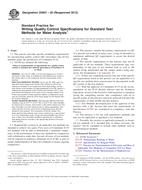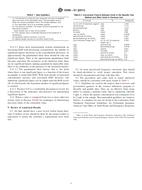Potřebujeme váš souhlas k využití jednotlivých dat, aby se vám mimo jiné mohly ukazovat informace týkající se vašich zájmů. Souhlas udělíte kliknutím na tlačítko „OK“.
ASTM E1850-04(2012)
Standard Guide for Selection of Resident Species as Test Organisms for Aquatic and Sediment Toxicity Tests
Automaticky přeložený název:
Standardní Příručka pro výběr Resident druhů jako testovací organismy pro vodní a sediment zkoušky toxicity
NORMA vydána dne 1.12.2012
Informace o normě:
Označení normy: ASTM E1850-04(2012)
Poznámka: NEPLATNÁ
Datum vydání normy: 1.12.2012
Kód zboží: NS-43306
Počet stran: 14
Přibližná hmotnost: 42 g (0.09 liber)
Země: Americká technická norma
Kategorie: Technické normy ASTM
Kategorie - podobné normy:
Anotace textu normy ASTM E1850-04(2012) :
Keywords:
aquatic toxicity testing, bioassessment, indigenous species, resident species, sediment toxicity testing, site-specific monitoring, ICS Number Code 13.060.45 (Examination of water in general)
Doplňující informace
| Significance and Use | ||||||||||||||||||||||||||||||||||||||||||||||||||||||||||||||||||||||||||||||||||||||||||||||||||||||||||||||||||
|
5.1 The USEPA's policy for whole-effluent monitoring stresses, an integrated approach to toxicity testing 5.2 This guide is intended to assist researchers and managers in selecting appropriate resident species for site-specific toxicity assessments. This guide could be used to select a resident species for use in predicting the potential toxic effects of a substance in certain types of aquatic environments. Another use might be for selecting a number of indigenous species from the aquatic community, that when tested, might indicate potential toxic effects of the test substance or material on the ecological integrity of that community. Selection of a suitable test species is very important because species might respond quite differently to toxic compounds (9). Species suggested as test organisms by regulatory agencies might not occur in the receiving waters of interest and their sensitivity to a toxic substance might not be representative of the sensitivity exhibited by resident species. Since aquatic ecosystem structure and function is often determined by a few key species 5.3 This guide can be used in the selection of representative test species for certain site-specific assessments, such as the Resident-Species Criteria Modification Procedure 5.4 This guide can be used as a general framework for researchers who desire to develop or modify existing toxicity test methods for previously untested species. 5.5 Researchers in countries other than the United States and Canada might obtain useful information from this guide regarding potential test species or test methods for sites of local interest. |
||||||||||||||||||||||||||||||||||||||||||||||||||||||||||||||||||||||||||||||||||||||||||||||||||||||||||||||||||
| 1. Scope | ||||||||||||||||||||||||||||||||||||||||||||||||||||||||||||||||||||||||||||||||||||||||||||||||||||||||||||||||||
|
1.1 This guide along with Guide E1192 and guidance from the U.S. Environmental Protection Agency 1.2 Because toxicological information is often limited for many aquatic species, it is assumed that the majority of testing applications will be acute tests. Therefore, much of the guidance presented in this guide pertaining to the species selection process is applicable when acute toxicity testing is the desired goal. However, the principles discussed in this guide pertain to chronic toxicity test applications as well, although it should be clearly understood that such testing requires substantially greater effort, time, and resources than acute testing. 1.3 The procedures for selecting resident species in toxicity testing are necessarily general at this time because information is often lacking for specific taxa or groups of taxa. This guide attempts to give specific information when appropriate. 1.4 This guide is not intended to be inclusive. References listed provide a starting point from which to approach the literature. This guide deals solely with aquatic toxicity test situations. Terrestrial, arboreal, or atmospheric species are not considered in this guide. 1.5 This guide is arranged as follows:
1.6 This standard does not
purport to address all of the safety concerns, if any, associated
with its use. It is the responsibility of the user of this standard
to establish appropriate safety and health practices and determine
the applicability of regulatory limitations prior to use.
Standard Practice for Collecting Benthic
Macroinvertebrates With Petersen Grab Sampler Standard Practice for Collecting Benthic
Macroinvertebrates With Orange Peel Grab Sampler Standard Guide for Selecting Stream-Net
Sampling Devices for Collecting Benthic Macroinvertebrates
(Withdrawn 2003) Standard Practice for Collecting Benthic
Macroinvertebrates with Surber and Related Type Samplers Standard Practice for Collecting Benthic
Macroinvertebrates With Drift Nets (Withdrawn 2003) Practice for Conducting Static Acute
Toxicity Tests on Waste-Waters with Daphnia (Withdrawn 1988) Standard Guide for Conducting Acute
Toxicity Tests on Test Materials with Fishes, Macroinvertebrates,
and Amphibians (Includes all amendments and changes 2/22/2023). Standard Guide for Conducting Static
Short-Term Chronic Toxicity Tests Starting with Embryos of Four
Species of Saltwater Bivalve Molluscs Standard Guide for Conducting Acute
Toxicity Tests on Aqueous Ambient Samples and Effluents with
Fishes, Macroinvertebrates, and Amphibians Standard Guide for Conducting Daphnia
magna Life-Cycle Toxicity Tests Standard Practice for Fluorescent Liquid
Penetrant Testing Using the Hydrophilic Post-Emulsification
Process Standard Guide for Conducting Static
Toxicity Tests with Microalgae Standard Guide for Conducting Early
Life-Stage Toxicity Tests with Fishes Standard Test Method for Measuring the
Toxicity of Sediment-Associated Contaminants with Estuarine and
Marine Invertebrates Guide for Conducting Sediment Toxicity
Tests with Freshwater Invertebrates (Withdrawn 1995) Standard Guide for Conducting Static
Toxicity Tests With Lemna gibba G3 Standard Guide for Acute Toxicity Test
with the Rotifer Brachionus Standard Guide for Conducting Static and
Flow-Through Acute Toxicity Tests With Mysids From the West Coast
of the United States Standard Guide for Conducting Sexual
Reproduction Tests with Seaweeds Standard Guide for Designing Biological
Tests with Sediments Standard Guide for Conducting Acute,
Chronic, and Life-Cycle Aquatic Toxicity Tests with Polychaetous
Annelids Standard Guide for Conducting Short-Term
Chronic Toxicity Tests with Echinoid Embryos (Includes all
amendments and changes 1/20/2022). Standard Guide for Conducting Sediment
Toxicity Tests with Polychaetous Annelids Standard Guide for Determination of the
Bioaccumulation of Sediment-Associated Contaminants by Benthic
Invertebrates Standard Test Method for Measuring the
Toxicity of Sediment-Associated Contaminants with Freshwater
Invertebrates Standard Guide for Conducting Static,
Axenic, 14-Day Phytotoxicity Tests in Test Tubes with the Submersed
Aquatic Macrophyte, Myriophyllum sibiricum Komarov Standard Guide for Conducting Toxicity
Tests with Bioluminescent Dinoflagellates Standard Guide for Conducting In-situ
Field Bioassays With Caged Bivalves Standard Guide for Conducting Life-Cycle
Toxicity Tests with Saltwater Mysids (Includes all amendments and
changes 1/27/2023). |
Podobné normy:
Historická
1.5.2011
Historická
15.6.2012
Historická
1.5.2011
Historická
15.7.2013
Historická
1.1.2013
Historická
1.9.2012
Doporučujeme:
Aktualizace zákonů
Chcete mít jistotu o platnosti užívaných předpisů?
Nabízíme Vám řešení, abyste mohli používat stále platné (aktuální) legislativní předpisy.
Chcete vědět více informací? Podívejte se na tuto stránku.



 ASTM D5241-92(2011)..
ASTM D5241-92(2011).. ASTM D5847-02(2012)..
ASTM D5847-02(2012).. ASTM D596-01(2011)..
ASTM D596-01(2011).. ASTM D6301-13
ASTM D6301-13 ASTM D6362-98(2013)..
ASTM D6362-98(2013).. ASTM D6538-12
ASTM D6538-12
 Cookies
Cookies
